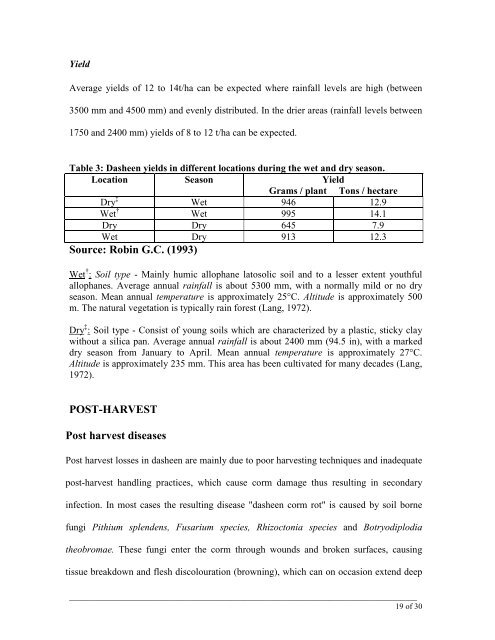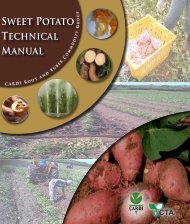Commercial dasheen (Colocasia esculenta (L.) Schott var ...
Commercial dasheen (Colocasia esculenta (L.) Schott var ...
Commercial dasheen (Colocasia esculenta (L.) Schott var ...
Create successful ePaper yourself
Turn your PDF publications into a flip-book with our unique Google optimized e-Paper software.
Yield<br />
Average yields of 12 to 14t/ha can be expected where rainfall levels are high (between<br />
3500 mm and 4500 mm) and evenly distributed. In the drier areas (rainfall levels between<br />
1750 and 2400 mm) yields of 8 to 12 t/ha can be expected.<br />
Table 3: Dasheen yields in different locations during the wet and dry season.<br />
Location Season Yield<br />
Grams / plant Tons / hectare<br />
Dry ‡ Wet 946 12.9<br />
Wet † Wet 995 14.1<br />
Dry Dry 645 7.9<br />
Wet Dry 913 12.3<br />
Source: Robin G.C. (1993)<br />
Wet † : Soil type - Mainly humic allophane latosolic soil and to a lesser extent youthful<br />
allophanes. Average annual rainfall is about 5300 mm, with a normally mild or no dry<br />
season. Mean annual temperature is approximately 25°C. Altitude is approximately 500<br />
m. The natural vegetation is typically rain forest (Lang, 1972).<br />
Dry ‡ : Soil type - Consist of young soils which are characterized by a plastic, sticky clay<br />
without a silica pan. Average annual rainfall is about 2400 mm (94.5 in), with a marked<br />
dry season from January to April. Mean annual temperature is approximately 27°C.<br />
Altitude is approximately 235 mm. This area has been cultivated for many decades (Lang,<br />
1972).<br />
POST-HARVEST<br />
Post harvest diseases<br />
Post harvest losses in <strong>dasheen</strong> are mainly due to poor harvesting techniques and inadequate<br />
post-harvest handling practices, which cause corm damage thus resulting in secondary<br />
infection. In most cases the resulting disease "<strong>dasheen</strong> corm rot" is caused by soil borne<br />
fungi Pithium splendens, Fusarium species, Rhizoctonia species and Botryodiplodia<br />
theobromae. These fungi enter the corm through wounds and broken surfaces, causing<br />
tissue breakdown and flesh discolouration (browning), which can on occasion extend deep<br />
______________________________________________________________________________________<br />
19 of 30




